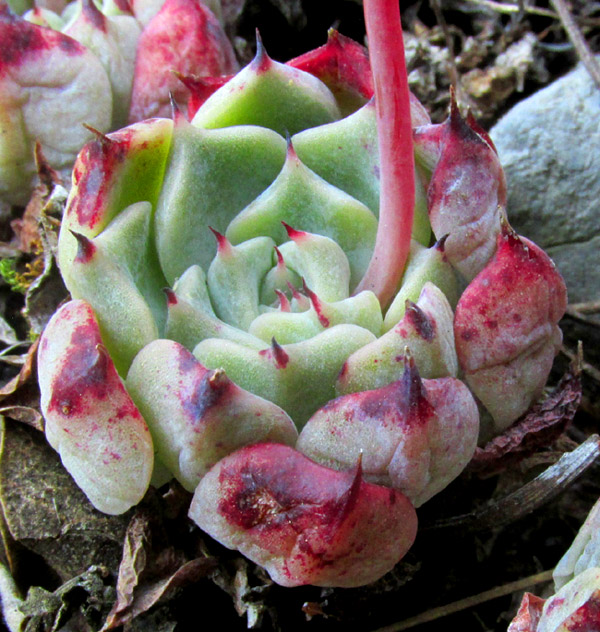Excerpts from Jim Conrad's
Naturalist Newsletter
entry from field notes dated May 5, 2023, taken about 150m uphill on NE-facing slope, above intersection of road from Hwy 120 to San Joaquín, with road to El Doctor; juniper and pine forest on limestone bedrock; elevation ±2425m (7950 ft); Eastern Sierra Madre mountains of east-central Querétaro state, MÉXICO, (N20.88°, W99.62°)
BLUE ECHEVERIAS

Sheltering between two large rocks in a narrow space usually in deep shadow, the above little colony of wildflowers were in full bloom, despite it being at the end of an exceptionally long, severe dry season. Such clusters of small, cabbage-like rosettes were reminiscent of the ornamental pot and garden plant Sempervivum, sometimes called hen and chicks. Sempervivum is a member of the Stonecrop Family, the Crassulaceae, so already this was a beginning to the identification process.

The inflorescence rose above its rosette of leaves as if inspired by the same impulse responsible for the graceful necks of swans.

Up close it was clear that these plants were not a species of sempervivum, whose corollas develop 8-16 lobes, and whose sepals below the corollas are all alike. The above corollas are 5-angled, and the sepals reach slightly different lengths. Also, sempervivums are Eurasian plants, not American.

The inflorescence's pink peduncle sprouted off-center in the rosette, and each silvery-green/glaucous leaf was tipped with a raspberry-colored tooth.
In upland central Mexico if you have a member of the Stonecrop Family with rosette-forming leaves, the flowers' partly tubular corollas possess no scale-like appendages at the inside bases of the lobes, and the corollas are noticeably angular in cross-section, you have the genus Echeveria. In English Echeveria species often are referred to as echeverias. The genus is named in honor of a Mexican botanical artist of the 1700s named Astanasio Echeverría y Godoy, and his Echeverría was pronounced accenting the í, and trilling the rr, but nowadays not many account for that when pronouncing the differently spelled "echeveria."
About 250 Echevaria species currently are recognized, and they're all native only to the Americas from Texas south to Argentina. With Mexico the genus' center of species diversity, in our central upland Mexico region known as the Bajío, about 18 species are known. Earlier, using the 2008 volume of the Flora del Bajío treating the genus, I identified this plant as Echeveria secunda. However, when the pictures were posted on iNaturalist, user yeonbinj recognized it as ECHEVERIA HALBINGERI, not mentioned in the Flora del Bajío or any other flora I can find. Since yeonbinj seems to know his Echeveria species, I'm accepting his call.
Echeveria secunda is more widely distributed in Mexico than Echeveria halbingeri, the former endemic to uplands in central and much of northern Mexico, while Echeveria halbingeri is said to be much narrower endemic, just in Hidalgo, Veracruz and here in Querétaro states.
Other than technical descriptions of the speches, I find no further information about Echeveria halbingeri.